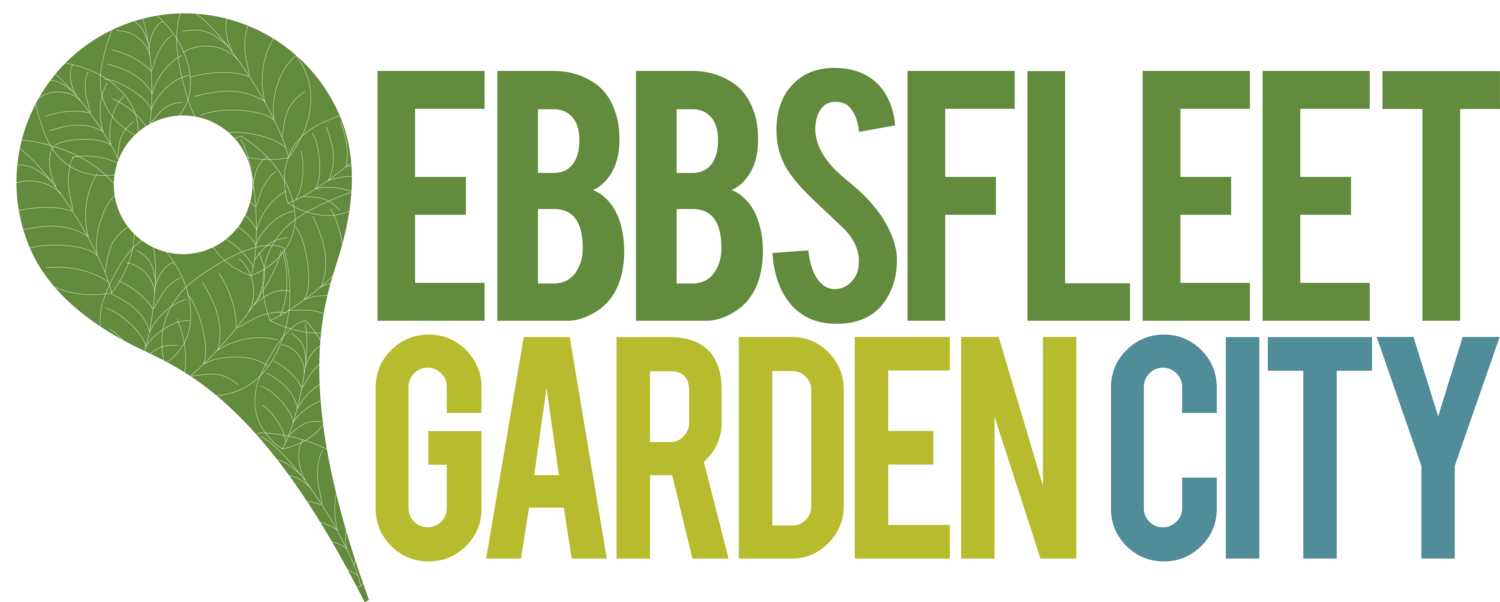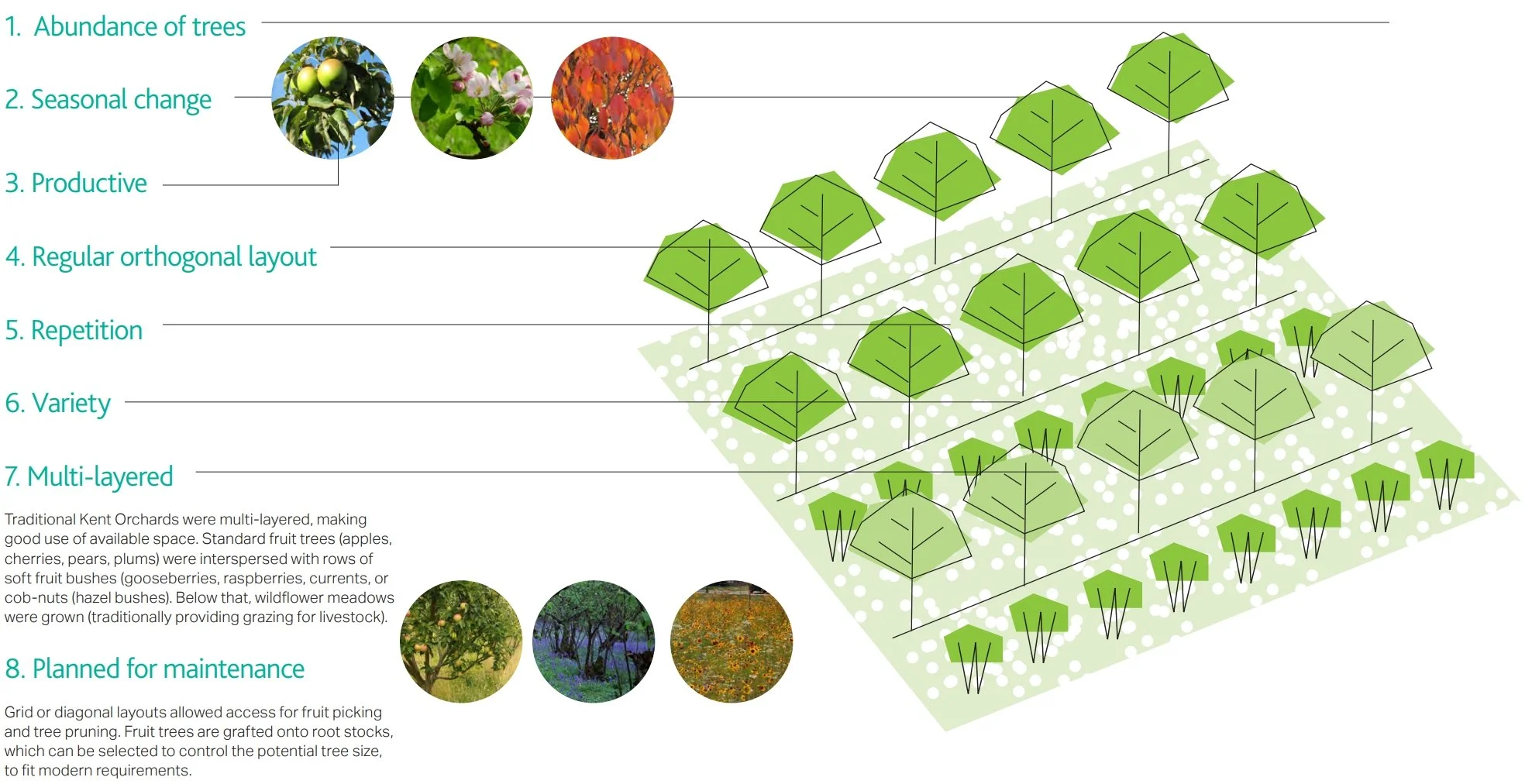Planting Narratives-
Garden of England
Planting colour palettes and design principles should be derived from the landscape character to enhance the qualities of the existing landscape character.
1. Abundance of trees
Street Levels 1-4
Leafy green streets to encourage walking, cycling and build communities. Street trees on all street types, levels 1-4. Trees to provide spatial structure, shade and shelter, and other green infrastructure services.
Parks
Leafy green parks to encourage walking and cycling, and social spaces for interaction and to build communities. Trees should be in included in all parks, to provide spatial structure, shade and shelter and other green infrastructure services.
Squares
Leafy green square to encourage walking and cycling, and social space for interaction and events to build communities. Trees should be in included in all parks, to provide spatial structure, shade and shelter and other green infrastructure services.
2. Seasonal change
Street Levels 1-4
Broadleaved deciduous trees, trees with blossom, berries, catkins, seeds or autumn leaf colour change will all add to seasonal change.
Parks
Broadleaved deciduous trees, trees with blossom, berries, catkins, seeds or autumn leaf colour change will all add to seasonal change. Grassed areas in park could include productive fruit trees or bushes.
Squares
Broadleaved deciduous trees, trees with blossom, berries, catkins, seeds or autumn leaf colour change will all add to seasonal change.
3. Productive
Street Levels 1-4
Use trees with ornamental blossom to reference orchards, avoiding soft fruit in places with hard surfaces where it could cause a slip hazard. Level 4 Home-zone streets could include hops trained on vertical supports, herbs, wild strawberries, espalier fruit. Planters could be made available to residents to grow fruit and vegetables.
Parks
Opportunities for planting community orchards, walnut trees, cobnut bushes, herbs, and other productive plants. Keep fruit bearing plants on soft surfaces, to avoid slip hazards. Allotments - raised beds could be included in larger parks subject to space. As these require fencing to protect crops from wildlife, a water supply, shared equipment storage shed etc., they may be better accommodated in larger specific allotment areas to support community interaction.
Squares
Use trees with ornamental blossom to reference orchards, avoiding growing soft fruit in places with hard surfaces where it could cause a slip hazard. Include herbs, nut trees (e.g. walnuts), hops trained on pergolas, wild strawberries.
4. Regular Orthogonal Layout
Street Levels 1-4
Level 1 & 2 streets - symmetrical pairs of trees, regularly spaced
Level 3 & 4 - more informally grouped trees
Parks
Opportunities for planting fruit trees or ornamental trees in rows or on a grid/diagonal grid, to reference the layout of traditional Kent orchards.
Squares
Opportunities for planting ornamental trees in rows or on a grid/ diagonal grid, to reference the layout of traditional Kent orchards.
5. Repetition
Street Levels 1-4
Create character and legibility with single species blocks of trees for shorter streets.
Parks
Create character and legibility with single species rows or blocks of trees.
Squares
Create character and legibility with single species rows or groups of trees.
6. Variety
Street Levels 1-4
Create character and legibility by varying the species - break up longer streets by blocks/character areas. Use the scale of trees to indicate the hierarchy of streets, to aid legibility. Biodiversity will also help to mitigate against the increasing globalisation of tree pests and diseases, and climate change.
Parks
Vary fruit trees by type and cultivar, to provide a variety of fruit, but match by pollination group. Vary form of productive plants - e.g. by rootstock (controls eventual size) and by pruning (controls shape). A varied palette of plants will create character and legibility, and biodiversity.
Squares
Create character and legibility by varying the species - break up squares to indicate functional use. Biodiversity will also help to mitigate against the increasing globalisation of tree pests and diseases, and climate change.
7. Multi-layered
Street Levels 1-4
Wide soft verges will provide tree rooting soil volumes. Verges can be planted with vibrant Pictorial meadows, mass herbaceous planting, perennial or shrub ground-cover, amenity grass and bulbs, or incorporate lushly planted rain gardens.
Parks
Trees planted in soft landscape to provide sufficient tree rooting soil volumes. Trees can be under-planted with Pictorial meadows, mass herbaceous planting, amenity grass, shrubs, ferns, bulbs. Train hops etc. on pergolas. Include fruit or nut bushes, hedges, espalier fruit trees, herbs and other edibles. Include lushly planted rain gardens.
Squares
Trees need sufficient root-able soil volume to establish and sustain them to reach their full potential. In hard spaces, trees will need this provided by Silva cells or Structural soil. Areas of lower level planting could include ground-cover shrubs, mass herbaceous planting, ornamental grasses, herbs, bulbs, with climbers such as hops trained on vertical supports/pergolas.
8. Planned for maintenance
Street Levels 1-4
Select trees that will grow to fill the space, but not to obstruct vehicles, lighting columns, or shade windows excessively. Plan for management such as crown-lifting, to keep lower tree branches from obstructing routes as the trees grow.
Parks
Ornamental flowering trees can be maintained as full sized standard trees, but productive trees may be harvested and managed more easily as half-standard trees, bushes, espaliers or cordons. Select all plants to fit the space, or specify management to keep them from obstructing access.
Squares
Select trees that will grow to fill the space, but not to obstruct vehicles, lighting columns, or shade windows excessively. Plan for management such as crown-lifting, to keep lower tree branches from obstructing routes as the trees grow.

